-
Countries
-
Data and Analysis
-
Special Focus
-
Crisis Responses
Feb 01 2023
Print
Type
Methodological framework
Published date
Wed, 02/01/2023 - 16:03

Contact
iomkenyaPI@iom.int
Language
English
Location
Kenya
Period Covered
Nov 21 2022
Dec 01 2022
Activity
- Site Assessment
To assess the drought-induced mobility and identify the most urgent sectoral needs experienced by drought-affected communities, the IOM’s Displacement Tracking Matrix (DTM)-Mobility Tracking and Multi-sectoral Location Assessment (MSLA) has been rolled out in Isiolo County.
Through this first assessment round in Isiolo, IOM has gathered basic information on population mobility dynamics and their sectoral needs, namely livelihoods, Water Sanitation and Hygiene (WASH), Health, Emergency Shelters, Non-Food Items (NFIs) and Education. The data collection was conducted across the entire three sub-counties of Isiolo County by enumerators in 10 Wards, 88 sub-locations and 566 settlements.
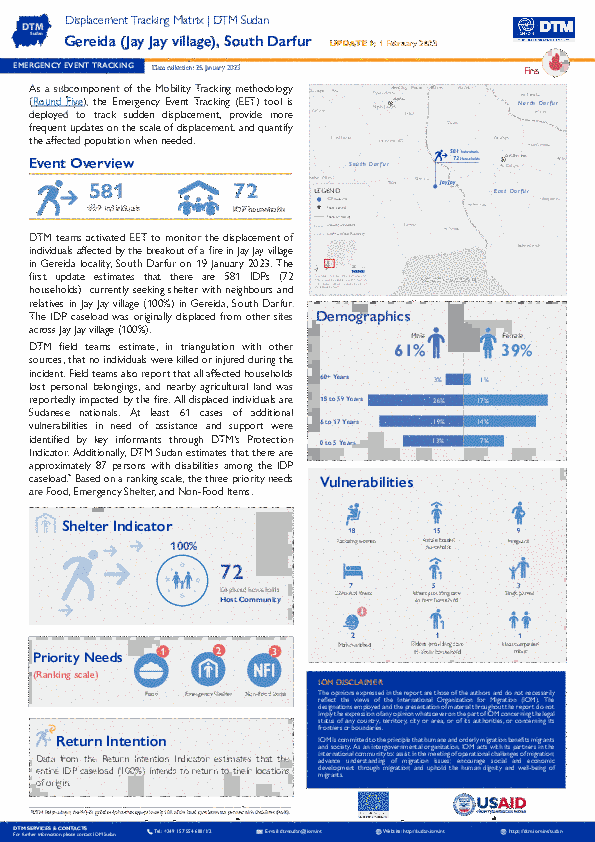
Contact
DTM Sudan; dtmsudan@iom.int
Language
English
Location
Sudan
Snapshot Date
Feb 25 2023
Activity
- Mobility Tracking
- Event Tracking
The DTM Emergency Event Tracking (EET) is deployed to track sudden displacement and population movements, provide more frequent updates on the scale of displacement, and quantify the affected population when needed. As a subcomponent of the new Mobility Tracking methodology in Sudan (Round Five), and activated on a need basis, EET utilises a broad network of key informants to capture best estimates of the affected population presence per location – a useful tool for humanitarian response planning and design.
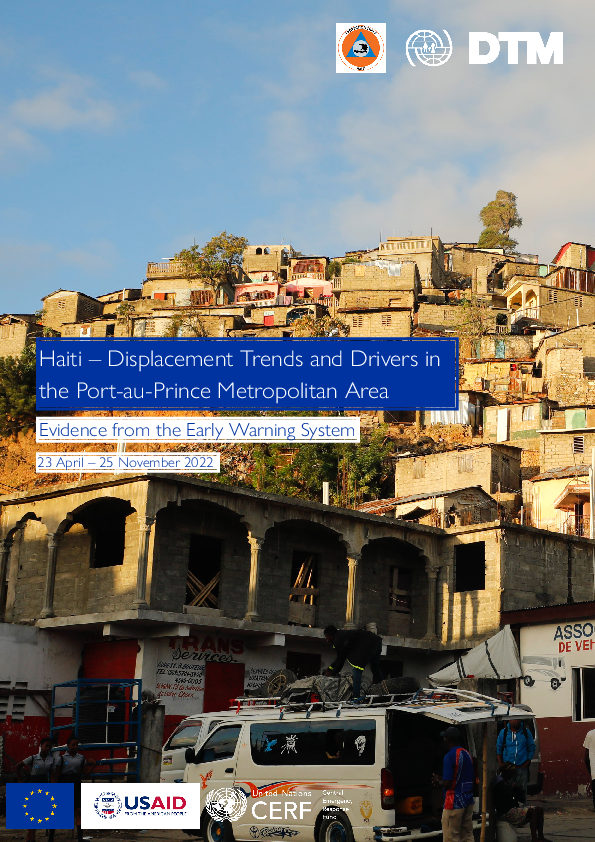
Contact
dtmhaiti@iom.int
Language
English
Location
Haiti
Period Covered
Apr 23 2022
Nov 25 2022
Activity
- Event Tracking
The Haitian capital, Port-au-Prince, has experienced an increase in the intensity of violence linked to inter-gang, gang-police and social conflicts since mid-2021. This has resulted in widespread insecurity in the Port-au-Prince Metropolitan Area and has been associated with large-scale urban displacement and an increase in humanitarian priority needs. This report presents the findings from nearly six months (1 May – 25 November 2022) of data collected by the International Organization for Migration (IOM)’s Displacement Tracking Matrix (DTM) and the Haitian Directorate General for Civil Protection, which have launched an early warning system to gather data on displacement, humanitarian shocks and basic protection indicators on an ongoing basis.
The early warning system recorded a total of 56,883 individual movement of internally displaced people and 42,439 individual arrivals throughout the assessment period. Key shocks experienced in the Haitian capital include generalized and targeted violence, the indirect effects of insecurity and flooding with peaks in violent shocks experienced in May and July and widespread insecurity identified throughout September and October. The socioeconomic situation of the ZMPP has been characterised by persistent increases in the price of food and non food items and high proportions of the population being unable to afford basic necessities.
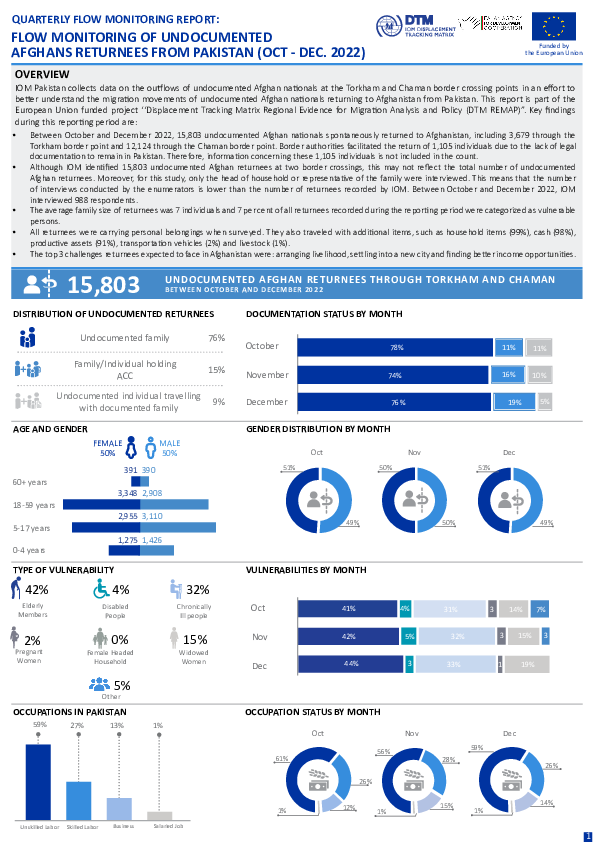
Contact
DTM Pakistan, iomisbdtmremapteam@iom.int
Language
English
Location
Pakistan
Period Covered
Oct 01 2022
Dec 31 2022
Activity
- Flow Monitoring
IOM Pakistan collects data on the outflows of undocumented Afghan nationals at the Torkham and Chaman border crossing points in an effort to better understand the migration movements of undocumented Afghan nationals returning to Afghanistan from Pakistan. This report is part of the European Union funded project ‘‘Displacement Tracking Matrix Regional Evidence for Migration Analysis and Policy (DTM REMAP)”. Key findings during this reporting period are:
• Between October and December 2022, 15,803 undocumented Afghan nationals spontaneously returned to Afghanistan, including 3,679 through the Torkham border point and 12,124 through the Chaman border point. Border authorities facilitated the return of 1266 individuals due to the lack of legal documentation to remain in Pakistan. Therefore, information concerning these 843 individuals is not included in the count.
• Although IOM identified 15,803 undocumented Afghan returnees at two border crossings, this may not reflect the total number of undocumented Afghan returnees. Moreover, for this study, only the head of household or representative of the family were interviewed. This means that the number of interviews conducted by the enumerators is lower than the number of returnees recorded by IOM. Between October and December 2022, IOM interviewed 988 respondents.
• The average family size of returnees was 7 individuals and 7 per cent of all returnees recorded during the reporting period were categorized as vulnerable persons.
• All returnees were carrying personal belongings when surveyed. They also traveled with additional items, such as household items (99%), cash (98%), productive assets (91%), transportation vehicles (2%) and livestock (1%).
• The top 3 challenges returnees expected to face in Afghanistan were: arranging livelihood, settling into a new city and finding better income opportunities.
Feb 01 2023
Print
Global
No
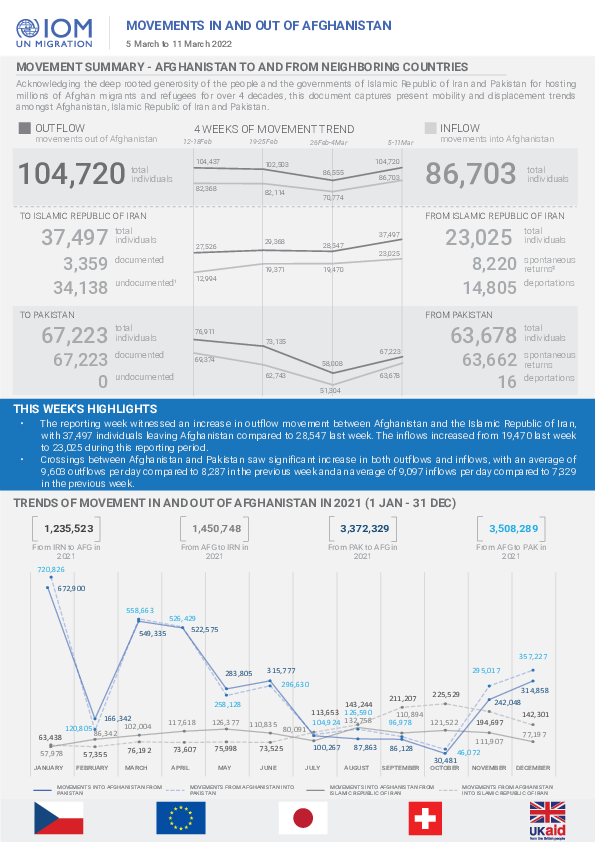
Contact
DTMAfghanistan@iom.int
Language
English
Location
Afghanistan
Period Covered
Mar 05 2022
Mar 11 2022
Activity
- Flow Monitoring
The snapshot captures present mobility and displacement trends between Afghanistan, the Islamic Republic of Iran and Pakistan.
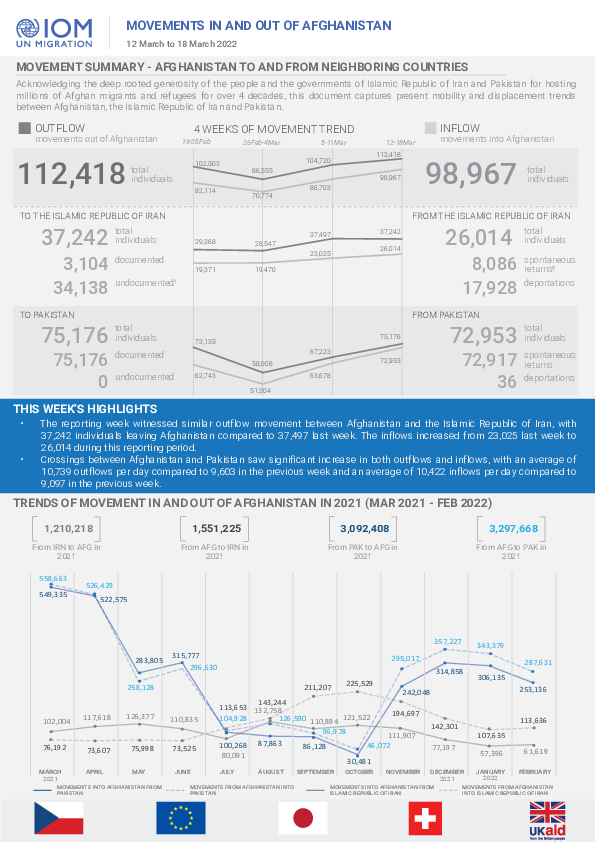
Contact
DTMAfghanistan@iom.int
Language
English
Location
Afghanistan
Period Covered
Mar 12 2022
Mar 18 2022
Activity
- Flow Monitoring
The snapshot captures present mobility and displacement trends between Afghanistan, the Islamic Republic of Iran and Pakistan.
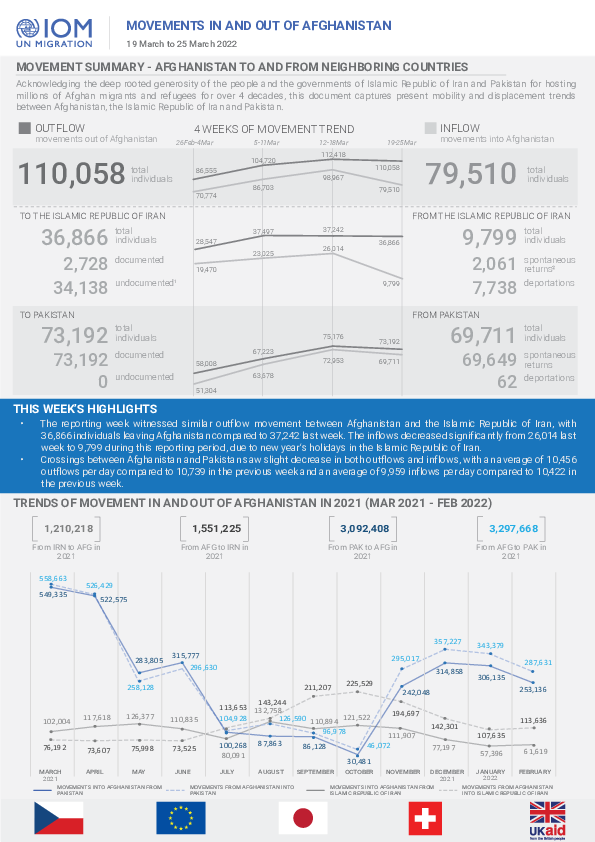
Contact
DTMAfghanistan@iom.int
Language
English
Location
Afghanistan
Period Covered
Mar 19 2022
Mar 25 2022
Activity
- Flow Monitoring
The snapshot captures present mobility and displacement trends between Afghanistan, the Islamic Republic of Iran and Pakistan.

Contact
DTMAfghanistan@iom.int
Language
English
Location
Afghanistan
Period Covered
Mar 26 2022
Apr 01 2022
Activity
- Flow Monitoring
The snapshot captures present mobility and displacement trends between Afghanistan, the Islamic Republic of Iran and Pakistan.
